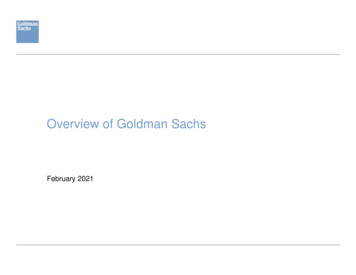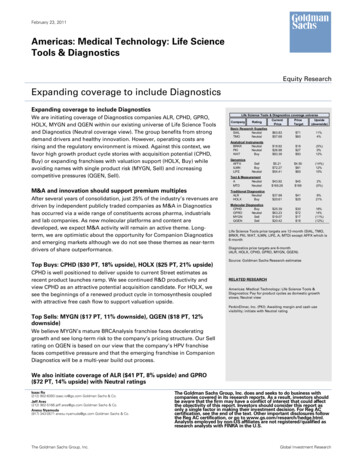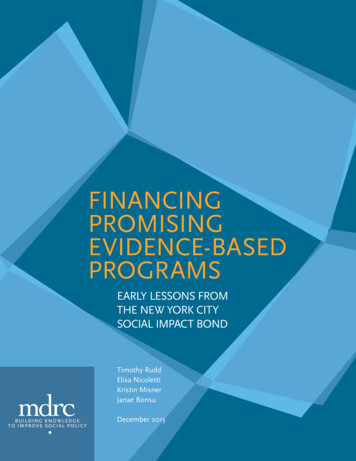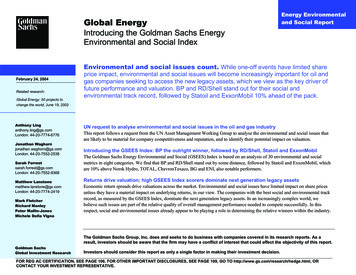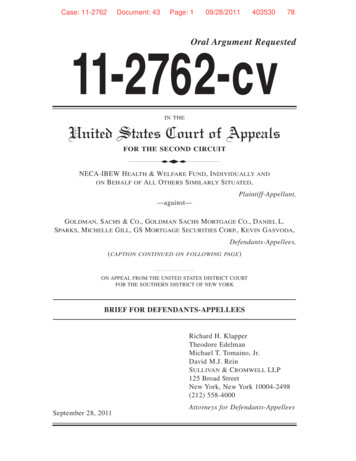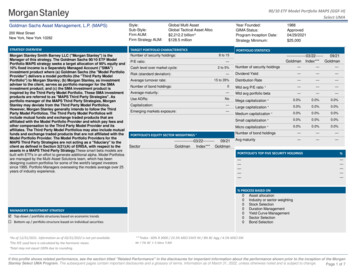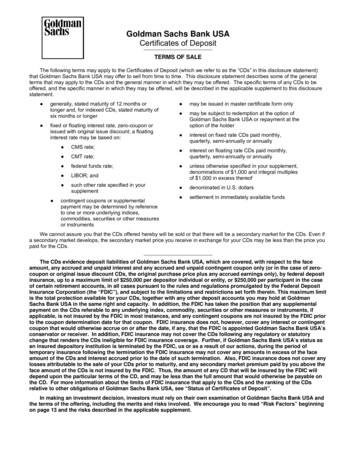
Transcription
Goldman Sachs Bank USACertificates of DepositTERMS OF SALEThe following terms may apply to the Certificates of Deposit (which we refer to as the “CDs” in this disclosure statement)that Goldman Sachs Bank USA may offer to sell from time to time. This disclosure statement describes some of the generalterms that may apply to the CDs and the general manner in which they may be offered. The specific terms of any CDs to beoffered, and the specific manner in which they may be offered, will be described in the applicable supplement to this disclosurestatement. generally, stated maturity of 12 months orlonger and, for indexed CDs, stated maturity ofsix months or longerfixed or floating interest rate, zero-coupon orissued with original issue discount; a floatinginterest rate may be based on: CMS rate; CMT rate; federal funds rate; LIBOR; and such other rate specified in yoursupplementcontingent coupons or supplementalpayment may be determined by referenceto one or more underlying indices,commodities, securities or other measuresor instruments may be issued in master certificate form only may be subject to redemption at the option ofGoldman Sachs Bank USA or repayment at theoption of the holder interest on fixed rate CDs paid monthly,quarterly, semi-annually or annually interest on floating rate CDs paid monthly,quarterly, semi-annually or annually unless otherwise specified in your supplement,denominations of 1,000 and integral multiplesof 1,000 in excess thereof denominated in U.S. dollars settlement in immediately available fundsWe cannot assure you that the CDs offered hereby will be sold or that there will be a secondary market for the CDs. Even ifa secondary market develops, the secondary market price you receive in exchange for your CDs may be less than the price youpaid for the CDs.The CDs evidence deposit liabilities of Goldman Sachs Bank USA, which are covered, with respect to the faceamount, any accrued and unpaid interest and any accrued and unpaid contingent coupon only (or in the case of zerocoupon or original issue discount CDs, the original purchase price plus any accrued earnings only), by federal depositinsurance, up to a maximum limit of 250,000 per depositor individual or entity, or 250,000 per participant in the caseof certain retirement accounts, in all cases pursuant to the rules and regulations promulgated by the Federal DepositInsurance Corporation (the “FDIC”), and subject to the limitations and restrictions set forth therein. This maximum limitis the total protection available for your CDs, together with any other deposit accounts you may hold at GoldmanSachs Bank USA in the same right and capacity. In addition, the FDIC has taken the position that any supplementalpayment on the CDs referable to any underlying index, commodity, securities or other measures or instruments, ifapplicable, is not insured by the FDIC in most instances, and any contingent coupons are not insured by the FDIC priorto the coupon determination date for that coupon. FDIC insurance does not, however, cover any interest or contingentcoupon that would otherwise accrue on or after the date, if any, that the FDIC is appointed Goldman Sachs Bank USA’sconservator or receiver. In addition, FDIC insurance may not cover the CDs following any regulatory or statutorychange that renders the CDs ineligible for FDIC insurance coverage. Further, if Goldman Sachs Bank USA’s status asan insured depository institution is terminated by the FDIC, us or as a result of our actions, during the period oftemporary insurance following the termination the FDIC insurance may not cover any amounts in excess of the faceamount of the CDs and interest accrued prior to the date of such termination. Also, FDIC insurance does not cover anylosses attributable to the sale of your CDs prior to maturity, and any secondary market premium paid by you above theface amount of the CDs is not insured by the FDIC. Thus, the amount of any CD that will be insured by the FDIC willdepend upon the particular terms of the CD, and may be less than the full amount that would otherwise be payable onthe CD. For more information about the limits of FDIC insurance that apply to the CDs and the ranking of the CDsrelative to other obligations of Goldman Sachs Bank USA, see “Status of Certificates of Deposit”.In making an investment decision, investors must rely on their own examination of Goldman Sachs Bank USA andthe terms of the offering, including the merits and risks involved. We encourage you to read “Risk Factors” beginningon page 13 and the risks described in the applicable supplement.
The CDs are obligations solely of Goldman Sachs Bank USA, and are not obligations of The Goldman SachsGroup, Inc. or any other affiliate of the Bank. In addition, the CDs are not guaranteed by The Goldman Sachs Group,Inc. or any other affiliate of the Bank.The CDs have not been nor will they be registered under the Securities Act of 1933 (the “Securities Act”), and arenot required to be so registered. Neither the Securities Exchange Commission (the “SEC”) nor any other regulatorybody has approved or disapproved of the CDs or passed upon the accuracy or adequacy of this disclosure statement,which has not been filed with the SEC. Any representation to the contrary is a criminal offense.Goldman Sachs Bank USA may offer and sell the CDs to or through one or more initial purchasers, dealers or directly topurchasers, on a continuous or delayed basis.Goldman, Sachs & Co. or any other affiliate of Goldman Sachs Bank USA may use this disclosure statement in a marketmaking transaction in any CD after its initial sale. If the CDs are purchased from Goldman, Sachs & Co. or any otheraffiliate of Goldman Sachs Bank USA, this disclosure statement is being used in a market-making transaction, unlessthe purchaser is informed otherwise in the confirmation of sale.Disclosure Statement dated December 19, 2011.
Goldman, Sachs & Co. and other affiliates of Goldman Sachs Bank USA may make a market inthe CDs after the initial offering and purchase and sell CDs as principal, but neither Goldman,Sachs & Co., nor any such other affiliate of Goldman Sachs Bank USA, will have any obligation todo so and any such market-making, if commenced, may be discontinued at any time withoutnotice. In the event that Goldman Sachs Bank USA, Goldman, Sachs & Co. or any other affiliate ofGoldman Sachs Bank USA purchases CDs in the secondary market, these purchases may besubject to certain regulatory conditions, including, if Goldman Sachs Bank USA, Goldman, Sachs& Co. or any other affiliate of Goldman Sachs Bank USA purchases CDs from a holder within sixdays after the date of initial issuance of such CDs, downward adjustments to the purchase priceto be paid to such holder to account for early withdrawal penalties imposed by Goldman SachsBank USA pursuant to Regulation D of the Board of Governors of the Federal Reserve System.Thus, if you sell a CD to Goldman Sachs Bank USA, or any of its affiliates, shortly after youpurchase and pay for it, you may receive a reduced price for your CD. See “Plan of Distribution”.The CDs may not be offered or sold outside of the United States.IN MAKING AN INVESTMENT DECISION, INVESTORS MUST RELY ON THEIR OWNEXAMINATION OF GOLDMAN SACHS BANK USA, THE FDIC AND THE TERMS OF THE OFFEREDCDS, INCLUDING THE MERITS AND RISKS INVOLVED. THE CDS HAVE NOT BEENRECOMMENDED BY ANY FEDERAL OR STATE SECURITIES COMMISSION OR OTHERREGULATORY AUTHORITY. FURTHERMORE, NO SUCH AUTHORITY HAS CONFIRMED THEACCURACY OR DETERMINED THE ADEQUACY OF THIS DOCUMENT. THE CDS HAVE NOT BEENREGISTERED, AND THIS DISCLOSURE STATEMENT HAS NOT BEEN FILED, WITH THE SEC. ANYREPRESENTATION TO THE CONTRARY IS A CRIMINAL OFFENSE.ANY PERSON MAKING THE DECISION TO ACQUIRE THE CDS SHALL BE DEEMED, ONBEHALF OF ITSELF AND THE HOLDER, BY ACQUIRING AND HOLDING THE CDS OREXERCISING ANY RIGHTS RELATED THERETO, TO REPRESENT THAT:(i) THE FUNDS THAT THE HOLDER IS USING TO ACQUIRE THE CDS ARE NOT THE ASSETSOF AN EMPLOYEE BENEFIT PLAN SUBJECT TO TITLE I OF THE EMPLOYEE RETIREMENTINCOME SECURITY ACT OF 1974, AS AMENDED (“ERISA”), A PLAN DESCRIBED IN ANDSUBJECT TO SECTION 4975 OF THE INTERNAL REVENUE CODE OF 1986, AS AMENDED (THE“CODE”), A GOVERNMENTAL PLAN SUBJECT TO ANY FEDERAL, STATE OR LOCAL LAW THATIS SIMILAR TO THE PROVISIONS OF SECTION 406 OF ERISA OR SECTION 4975 OF THE CODE,OR AN ENTITY WHOSE UNDERLYING ASSETS INCLUDE “PLAN ASSETS” BY REASON OFDEPARTMENT OF LABOR REGULATION SECTION 2510.3-101, AS MODIFIED BY SECTION 3(42)OF ERISA, OR OTHERWISE; OR(ii) (A) THE HOLDER WILL RECEIVE NO LESS AND PAY NO MORE THAN “ADEQUATECONSIDERATION” (WITHIN THE MEANING OF SECTION 408(B)(17) OF ERISA AND SECTION4975(F)(10) OF THE CODE) IN CONNECTION WITH THE PURCHASE AND HOLDING OF THE CDS;(B) NONE OF THE PURCHASE, HOLDING OR DISPOSITION OF THE CDS OR THE EXERCISE OFANY RIGHTS RELATED TO THE CDS WILL RESULT IN A NON-EXEMPT PROHIBITEDTRANSACTION UNDER ERISA OR THE CODE (OR WITH RESPECT TO A GOVERNMENTAL PLAN,UNDER ANY SIMILAR APPLICABLE LAW OR REGULATION); AND (C) NEITHER GOLDMANSACHS BANK USA NOR ANY OF ITS AFFILIATES IS A “FIDUCIARY” (WITHIN THE MEANING OFSECTION 3(21) OF ERISA OR, WITH RESPECT TO A GOVERNMENTAL PLAN, UNDER ANYSIMILAR APPLICABLE LAW OR REGULATION) WITH RESPECT TO THE PURCHASER ORHOLDER IN CONNECTION WITH SUCH PERSON’S ACQUISITION, DISPOSITION OR HOLDING OFTHE CDS, OR AS A RESULT OF ANY EXERCISE BY GOLDMAN SACHS BANK USA OR ANY OFITS AFFILIATES OF ANY RIGHTS IN CONNECTION WITH THE CDS, AND NO ADVICE PROVIDEDBY GOLDMAN SACHS BANK USA OR ANY OF ITS AFFILIATES HAS FORMED A PRIMARY BASIS-1-
FOR ANY INVESTMENT DECISION BY OR ON BEHALF OF SUCH PURCHASER OR HOLDER INCONNECTION WITH THE CDS AND THE TRANSACTIONS CONTEMPLATED WITH RESPECT TOTHE CDS.-2-
AVAILABLE INFORMATIONInformation about Goldman Sachs Bank USAGoldman Sachs Bank USA submits quarterly to its primary federal regulator certain reports called“Consolidated Reports of Condition and Income” (the “call reports”) on Federal Financial InstitutionsExamination Council (“FFIEC”) Form 031. Each call report consists of a balance sheet, incomestatement, changes in equity capital and other supporting schedules as of the end of the period to whichsuch call report relates. The call reports are prepared in accordance with generally accepted accountingprinciples; however, reporting classifications used in the preparation of the reports differ, in some cases,from reporting classifications that are used to prepare the consolidated financial statements of TheGoldman Sachs Group, Inc. While the call reports are supervisory and regulatory documents, they arenot primarily accounting documents. The call reports are not audited and do not provide a completerange of financial disclosure about Goldman Sachs Bank USA. Nevertheless, the call reports provideimportant information concerning the financial condition and results of operations of Goldman Sachs BankUSA. Certain portions of the call reports are not publicly available. The publicly available portions ofeach call report filed by Goldman Sachs Bank USA for the quarterly periods ended March 31, 2011, June30, 2011 and September 30, 2011 and for the quarterly periods in the years ended December 31, 2010,December 31, 2009 and December 31, 2008, and any amendment or supplement thereto, areincorporated by reference into this disclosure statement. The publicly available portions of any call reportfiled by Goldman Sachs Bank USA with the FDIC subsequent to the date of this disclosure statement anduntil we complete our offering of the CDs, or if later, the date on which any of our affiliates ceases offeringand selling the CDs, shall be incorporated by reference into this disclosure statement from the date of thefiling of such call report. The publicly available portions of the call reports of Goldman Sachs Bank USAare on file with, and publicly available upon written request to, the FDIC, 3501 North Fairfax Drive, RoomE-1002, Arlington, Virginia 22226, Attention: Public Information Center, or by calling the FDIC PublicInformation Center at 877-275-3342 or 703-562-2200. The call reports are also available on the Internetwebsite of the FFIEC at https://cdr.ffiec.gov/public.NOTICE TO INVESTORSThe CDs have not been nor will they be registered under the Securities Act, and are not required tobe so registered, and thus are not entitled to the protections of the Securities Act that would apply if theCDs were registered.GOLDMAN SACHS BANK USAGoldman Sachs Bank USA, a New York State-chartered bank and a member of the Federal ReserveSystem and the FDIC, is regulated by the Board of Governors of the Federal Reserve System (the“Federal Reserve Board”) and the New York State Banking Department. Goldman Sachs Bank USA wasformed in November 2008 through the merger of The Goldman Sachs Group, Inc.’s existing Utahindustrial bank (named “Goldman Sachs Bank USA”) into its New York limited purpose trust company,with the surviving company taking the name “Goldman Sachs Bank USA”. Concurrently with this merger,The Goldman Sachs Group, Inc. contributed subsidiaries with an aggregate of 117.16 billion of assetsinto Goldman Sachs Bank USA (which brought total assets in Goldman Sachs Bank USA to 145.06billion as of November 2008). As a result, a number of The Goldman Sachs Group, Inc.’s businesses arenow conducted partially or entirely through Goldman Sachs Bank USA, including: bank loan trading andmortgage loan origination and/or trading; interest rate, credit, currency and other derivatives; leveragedfinance; investing in debt securities; agency lending; and certain administration services. The businessesconducted through Goldman Sachs Bank USA are subject to regulation by the Federal Reserve Board,the New York State Banking Department and the FDIC. The CDs will be issued by the Bank through itsbranch in New York.-3-
The annual audited financial statements of Goldman Sachs Bank USA are available at the followingInternet website: ml.As of December 16, 2011, Goldman Sachs Bank USA’s long-term bank deposit rating, short-termbank deposit rating and outlook by Moody’s Investors Service are “Aa3”, “P-1” and “Negative”,respectively, and Goldman Sachs Bank USA’s long-term bank deposit rating and short-term bank depositrating by Fitch Ratings are “A ” and “F1”, respectively. Ratings are not a recommendation to buy, sell orhold CDs and each rating should be evaluated independently of each other. In addition, ratings aresubject to change at any time without notice from Goldman Sachs Bank USA.THE GOLDMAN SACHS GROUP, INC.Goldman Sachs Bank USA is a wholly-owned subsidiary of The Goldman Sachs Group, Inc. TheGoldman Sachs Group, Inc. is a leading global financial services firm providing investment banking,securities and investment management services to a substantial and diversified client base that includescorporations, financial institutions, governments and high-net-worth individuals. Founded in 1869, thefirm is headquartered in New York and maintains offices in London, Frankfurt, Tokyo, Hong Kong andother major financial centers around the world.The CDs are obligations solely of the Bank, and are not obligations of The Goldman Sachs Group,Inc. or any other affiliate of the Bank. In addition, the CDs are not guaranteed “Obligations”, as such termis defined in the Amended and Restated General Guarantee Agreement, dated November 21, 2011, andthus are not guaranteed by The Goldman Sachs Group, Inc.SUPERVISION AND REGULATIONGeneralAs a New York State-chartered bank, Goldman Sachs Bank USA is supervised and examined by theNew York State Banking Department. Goldman Sachs Bank USA is a member bank of the FederalReserve System and, as such, is also regulated by the Federal Reserve Board and supervised andexamined by the Federal Reserve Bank of New York. The deposits of Goldman Sachs Bank USA areinsured up to the applicable limits by the FDIC. As a result, Goldman Sachs Bank USA is also subject tocertain regulations of the FDIC. The Federal Reserve Board’s policies and regulations also influence,directly or indirectly, the rates of interest paid by commercial banks on their time and savings deposits.The nature and impact on Goldman Sachs Bank USA of future changes in economic conditions andmonetary and fiscal policies, both foreign and domestic, are not predictable.Depositor PreferenceUnder the Federal Deposit Insurance Act (the “FDIA”), in the event of a liquidation or other resolutionof an insured depository institution, the claims of holders (including the FDIC, as the subrogee of suchholders) of deposit liabilities of such an institution (including the CDs), although subordinated in right tothe claims of a receiver of such bank for administrative expenses, are entitled to priority over the claims ofgeneral unsecured non-depositor creditors of such institution. By the terms of such law, the federaldepositor preference statute does not supersede the law of any state, except to the extent such state lawis inconsistent with such statute, and then only to the extent of such inconsistency.-4-
Payments of Uninsured Deposits by the FDIC in Connection with the Insolvency of an InsuredDepository InstitutionIf Goldman Sachs Bank USA becomes insolvent and the FDIC is appointed its conservator orreceiver, the amount actually paid by the FDIC in this capacity on the claims of holders of the CDs inexcess of the amount insured by the FDIC and paid under FDIC insurance would depend upon, amongother factors, the amount of conservatorship or receivership assets available for the payment of claims ofdeposit liabilities. See “—Depositor Preference” above and “Status of Certificates of Deposit” below.The FDIC as conservator or receiver may transfer to a new obligor any of Goldman Sachs Bank USAassets and liabilities, including the CDs, without the approval of Goldman Sachs Bank USA’s creditors,including holders of the CDs.In its resolution of the problems of an insured depository institution in default or in danger of default,the FDIC is generally obligated to satisfy its obligations to insured depositors at the least possible cost tothe deposit insurance fund. In addition, the FDIC may not take any action that would have the effect ofincreasing the losses to the deposit insurance fund by protecting depositors for more than the insuredportion of deposits. The FDIA authorizes the FDIC to settle all uninsured and unsecured claims in theinsolvency of an insured bank by making a final settlement payment after the declaration of insolvency.Such a payment would constitute full payment and disposition of the FDIC’s obligations to claimants. Therate of such final settlement payment is to be a percentage rate determined by the FDIC reflecting anaverage of the FDIC’s recovery experience for the receivership.Each insured depository institution “controlled” (as defined in the U.S. Bank Holding Company Act of1956) by the same bank holding company can be held liable to the FDIC for any loss incurred, orreasonably expected to be incurred, by the FDIC due to the default of any other insured depositoryinstitution controlled by that holding company and for any assistance provided by the FDIC to any ofthose banks that is in danger of default. Such a “cross-guarantee” claim against a depository institution isgenerally superior in right of payment to claims of the holding company and its affiliates against thatdepository institution. At this time, The Goldman Sachs Group, Inc. controls only one insured depositoryinstitution for this purpose, namely Goldman Sachs Bank USA. However, if, in the future, The GoldmanSachs Group, Inc. were to control other insured depository institutions, such cross-guarantee would applyto all such insured depository institutions.STATUS OF CERTIFICATES OF DEPOSITGoldman Sachs Bank USA is a member of the FDIC, an independent agency of the United Statesgovernment established in 1933 to insure bank deposits and thereby help maintain sound conditions inthe nation’s banking system. The FDIC pays the claims of depositors of a failed bank (up to a maximumlimit of 250,000 per depositor individual or entity, or in the case of deposits in certain retirementaccounts, effective April 1, 2006, up to a maximum limit of 250,000 per participant), from a depositinsurance fund that is supported by assessments against the FDIC’s member banks. Any accounts ordeposits a holder maintains directly with Goldman Sachs Bank USA in the same legal capacity as suchholder maintains its CDs would be aggregated with such CDs for purposes of the 250,000 per depositorlimit or the 250,000 per participant limit in the case of certain retirement accounts, as applicable. Inaddition, under applicable law, in the event of a liquidation or other resolution of an insured bank such asGoldman Sachs Bank USA, the claims of holders of deposit liabilities of such bank, althoughsubordinated in right to the claims of a receiver of such bank for administrative expenses, are entitled topriority over the claims of general unsecured non-depositor creditors of such bank.Applicability of FDIC Insurance to Future Payments, Contingent Coupons and Other SupplementalPaymentsThe CDs evidence deposit liabilities of Goldman Sachs Bank USA and are insured, withrespect to the face amount, any accrued and unpaid interest and any accrued and unpaid-5-
contingent coupon only (or in the case of zero-coupon or original issue discount CDs, the originalpurchase price plus any accrued earnings only), up to applicable limits by the FDIC and entitled topriority over the claims of general unsecured non-depositor creditors of Goldman Sachs BankUSA in the event of a liquidation or other resolution of Goldman Sachs Bank USA; however, theultimate determination of the insurability and priority of the CDs would be made by the FDIC inresponse to claims of depositors. FDIC insurance may not cover amounts payable on the CDs ifthere is a regulatory or statutory change in the future that renders CDs with terms similar to theCDs ineligible for FDIC insurance. Further, if Goldman Sachs Bank USA’s status as an insureddepository institution is terminated by the FDIC, us or as a result of our actions, during the periodof temporary insurance following the termination the FDIC insurance may not cover any amountsin excess of the face amount of the CDs and interest accrued prior to the date of such termination.In addition, the availability of FDIC insurance to an owner of a beneficial interest in a mastercertificate representing CDs may be dependent upon, among other things, whether such interestand any intermediary interests are accurately and adequately disclosed on the records of thedepositary, participants and persons that hold interests through participants. Accordingly, noassurance can be given as to the availability of FDIC insurance to owners of a beneficial interestin the CDs.For the purposes of calculating the insured amount with respect to zero-coupon or original issuediscount CDs, the amount insured (subject to the applicable limit) will be the original purchase price plusthe amount of earnings accrued to the date of default of Goldman Sachs Bank USA, calculated bycompounding interest annually at the rate necessary to increase the original purchase price to thematurity value over the life of the CDs.Although FDIC insurance coverage includes principal, any accrued and unpaid interest and anyaccrued and unpaid contingent coupon to the date of default of Goldman Sachs Bank USA (or in the caseof zero-coupon or original issue discount CDs, the original purchase price plus any accrued earningsonly), subject to the applicable limit, if the FDIC was appointed conservator or receiver of Goldman SachsBank USA prior to the determination date of the CDs, the FDIC has taken the position that anysupplemental payment on the CDs referable to any underlying index, commodity, securities or othermeasures or instruments, if applicable, between the date of deposit and the date the FDIC was appointedreceiver or conservator is not insured because such supplemental payment is not calculated until thedetermination date of the CDs and would not be reflected as accrued interest on the books of GoldmanSachs Bank USA at the time of such appointment. For similar reasons, any contingent coupon that hasnot already accrued on the books of Goldman Sachs Bank USA at the time of such appointment will notbe insured. Thus, if a supplemental amount payable on any CD at maturity is to be determined byreference to any index, commodity, securities or other measures or instruments, or the CD bears acontingent coupon, the amount insured by the FDIC with respect to that CD may be substantially lessthan the amount that would otherwise be payable on the CD (and could be less than the applicable FDICinsurance limits). Similarly, FDIC insurance would not cover any interest that was not accrued on thebooks and records of Goldman Sachs Bank USA prior to the date of the FDIC’s appointment as receiveror conservator. Any amounts payable on the CDs in respect of any redemption or repurchase option, tothe extent that such payments exceed the principal, any accrued and unpaid interest and any accruedand unpaid contingent coupon only, will not be covered by FDIC insurance. In addition, FDIC insurancemay not cover amounts payable on the CDs if there is a regulatory or statutory change in the future thatrenders CDs with terms similar to the CDs ineligible for FDIC insurance. Further, if Goldman Sachs BankUSA’s status as an insured depository institution is terminated by the FDIC, us or as a result of ouractions, during the period of temporary insurance following the termination the FDIC insurance may notcover any amounts in excess of the face amount of the CDs and interest accrued prior to the date of suchtermination. In addition, the FDIC takes the position that any secondary market premium paid by youabove the face amount of the CDs is not insured by the FDIC. If you sell your CDs prior to maturity,FDIC insurance will not cover any resulting losses.For the reasons described above, the maximum amount of any CD that will be insured by theFDIC will depend in part on the particular terms of the CD and may be substantially less than the-6-
amount otherwise payable on the CD (and could be less than the applicable FDIC insurancelimits). You should refer to the applicable supplement to this disclosure statement for adescription of the particular terms of your CD in order to determine the maximum insured amount.Goldman Sachs Bank USA will not be obligated to make any payments to any holder in satisfaction ofany loss such holder might incur, including losses that result from (i) a delay in insurance payoutsapplicable to its CDs, (ii) its receipt of a decreased rate of return on the reinvestment of the proceedsreceived as a result of a payment on the CDs prior to its stated maturity or (iii) payment in cash of the faceamount, any accrued and unpaid interest and any accrued and unpaid contingent coupon only (or in thecase of zero-coupon or original issue discount CDs, the original purchase price plus any accruedearnings only) prior to maturity in connection with the liquidation of an insured institution or theassumption of all or a portion of its deposit liabilities at a lower interest rate.No broker will be obligated to any holder for amounts not covered by FDIC insurance nor will they beobligated to make any payments to any holder in satisfaction of any loss such holder might incur,including losses that result from (i) a delay in insurance payouts applicable to its CDs, (ii) its receipt of adecreased rate of return on the reinvestment of the proceeds received as a result of a payment on theCDs prior to its stated maturity, (iii) payment in cash of the face amount, any accrued and unpaid interestand any accrued and unpaid contingent coupon only (or in the case of zero-coupon or original issuediscount CDs, the original purchase price plus any accrued earnings only) prior to maturity in connectionwith the liquidation of an insured institution or the assumption of all or a portion of its deposit liabilities at alower interest rate or (iv) its receipt of a decreased rate of return as compared to the terms of the CDs.In the event Goldman Sachs Bank USA’s status as an insured depository institution is terminated bythe FDIC or Goldman Sachs Bank USA, the insured deposits of each depositor in Goldman Sachs BankUSA on the date of such termination, less all subsequent withdrawals from such deposits by suchdepositor, will continue to be insured pursuant to temporary insurance for a period of at least six monthsor up to two years, within the discretion of the FDIC; however, it is unclear whether any amounts inexcess of the face amount of the CDs during a period of temporary insurance would be insured.FDIC Insurance in Cases of Merger or ConsolidationIf the CDs or other deposits of a holder at Goldman Sachs Bank USA are assumed by anotherdepository institution pursuant to a merger or consolidation, such CDs or deposits will continue to beseparately insured from the deposits that such holder might have established with the acquirer until atleast the expiration of a six-month grace period from the date of the acquisition. Such CDs or deposits ofa holder at Goldman Sachs Bank USA would be separately insured until the earliest maturity date afterthe end of the six-month grace period. Any such CDs that mature during the six-month grace period andare renewed for the same term and in the same dollar amount (either with or without accrued interest, ifany) would continue to be separately insured until the first maturity date after the six-month grace period.If such CDs mature during the six-month grace period and are renewed on any other basis, they would beseparately i
Goldman Sachs Bank USA may offer and sell the CDs to or through one or more initial purchasers, dealers or directly to purchasers, on a continuous or delayed basis. Goldman, Sachs & Co. or any other affiliate of Goldman Sachs Bank USA may use this disclosure statement in a market-making transaction in any CD after its initial sale.
